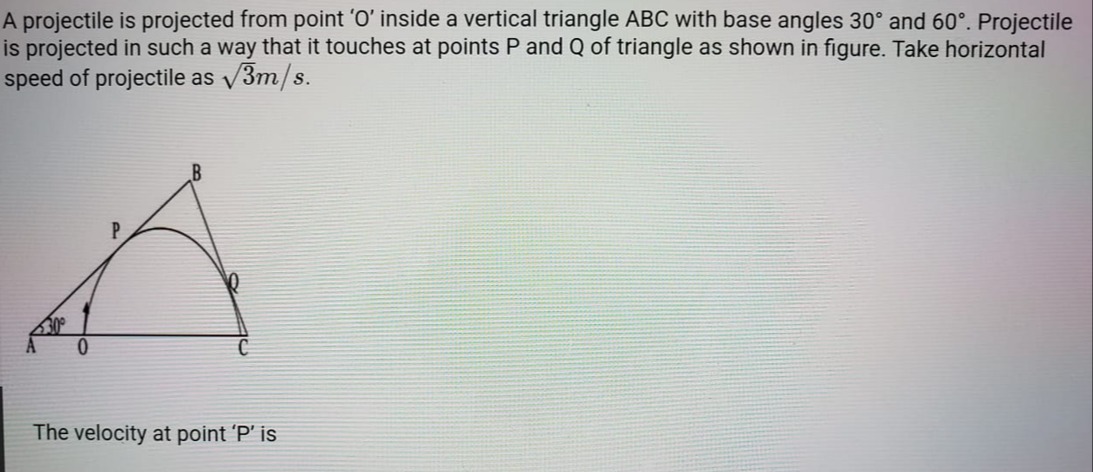Question
Question: A projectile is projected from point 'O' inside a vertical triangle ABC with base angles 30° and 60°...
A projectile is projected from point 'O' inside a vertical triangle ABC with base angles 30° and 60°. Projectile is projected in such a way that it touches at points P and Q of triangle as shown in figure. Take horizontal speed of projectile as 3m/s.
The velocity at point 'P' is

1 m/s
2 m/s
3 m/s
4 m/s
2 m/s
Solution
The problem asks for the velocity of the projectile at point P.
-
Understand the projectile motion properties:
- The horizontal component of the projectile's velocity (vx) remains constant throughout the motion because there is no horizontal acceleration (neglecting air resistance). We are given vx=3 m/s.
- At any point on the trajectory, the velocity vector is tangent to the path.
-
Analyze the velocity at point P:
- Point P is where the projectile's path touches the side AB of the triangle. This means the side AB is tangent to the projectile's trajectory at P.
- The angle that side AB makes with the horizontal base AC is given as 30°. Therefore, the velocity vector at point P makes an angle of 30° with the horizontal.
- Let the velocity at P be vP. Its horizontal component is vxP and its vertical component is vyP.
-
Calculate the components of velocity at P:
- Horizontal component: vxP=vx=3 m/s.
- Vertical component: The tangent of the angle the velocity vector makes with the horizontal is the ratio of the vertical component to the horizontal component. tan(30∘)=vxPvyP We know tan(30∘)=31. So, 31=3 m/svyP. Solving for vyP: vyP=3×31=1 m/s.
-
Determine the velocity at P:
The velocity at point P can be expressed as a vector: vP=vxPi^+vyPj^=3i^+1j^ m/s.
The magnitude of the velocity at P (speed at P) is: vP=vxP2+vyP2 vP=(3)2+(1)2 vP=3+1 vP=4 vP=2 m/s.
The direction of the velocity at P is 30° above the horizontal.
Since the question asks for "The velocity at point 'P'" without specifying "speed" or "components", it typically implies the magnitude of the velocity in such contexts.
